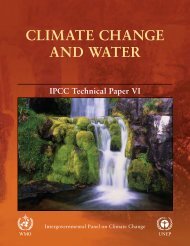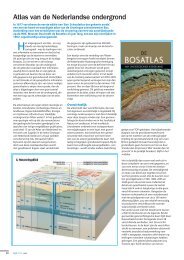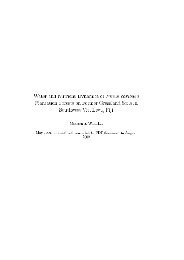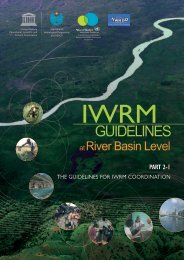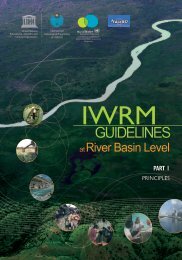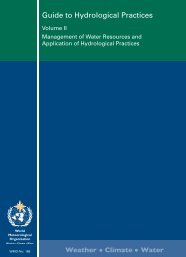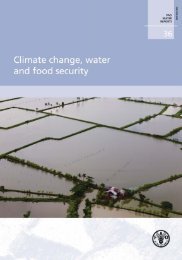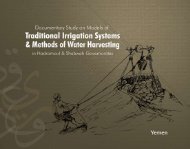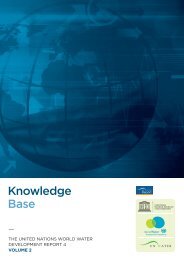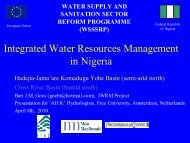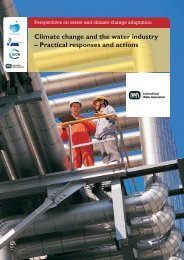Non-renewable groundwater resources: a ... - unesdoc - Unesco
Non-renewable groundwater resources: a ... - unesdoc - Unesco
Non-renewable groundwater resources: a ... - unesdoc - Unesco
- No tags were found...
Create successful ePaper yourself
Turn your PDF publications into a flip-book with our unique Google optimized e-Paper software.
CHAPTER 1 ■ CONCEPT AND IMPORTANCE OF NON-RENEWABLE RESOURCESTable 2. Hydrogeological concept of <strong>groundwater</strong> resource renewalPARAMETER SYMBOL DIMENSION UNITS“Groundwater resource renewal is the replacement or displacementof <strong>groundwater</strong> in aquifer storage through aquifer recharge ”Total drainable aquiferS Lstorage reserves*Mm 3 **Average annual aquiferrecharge rateR L 3 /T Mm 3 /aRate of aquifer<strong>groundwater</strong> renewalR/S L 3 /TL 3 x 100 %/aRenewal periodof aquiferS/R L 3 T/L 3 year“Renewal is a comparative (not absolute) concept – relative to both aquifer storage and rechargeAND thus subject to very wide variation due to geological factors (aquifer thicknessand drainable porosity) and climatic parameters (especially rainfall regime) ”Notes:* It is recognised that the definition of the term 'drainable aquifer storage' will be rather subjective in practice.** Mm 3 (10 6 m 3 ) also referred to as hm3 in many countries, and km 3 (10 9 m 3 ) also frequently used for large aquifers.L = lenght, T = time.Most importantly the development of non-<strong>renewable</strong> <strong>groundwater</strong> <strong>resources</strong> will imply the‘mining of aquifer storage reserves’ (Table 1), such that they will not be available for future strategicuse. As such it has special social, economic and political sensitivity compared to otherwater resource development.The occurrence of non-<strong>renewable</strong> <strong>resources</strong> in a variety of different hydrogeological settingsresults in a number of important consequences for their management :● some non-<strong>renewable</strong> aquifers sustain (directly or indirectly) important aquatic ecosystems(eg. Figures 1A and B);● non-<strong>renewable</strong> <strong>groundwater</strong> can be vulnerable to pollution from inadequately-controlledhuman activities at the land surface, especially the discharge of polluted and/or salinewastewater (eg. as would be the case in Figures 1 A and C);● the clearance of natural vegetation could reactivate deep <strong>groundwater</strong> recharge under certainconditions (eg. Figure 1C), but would also be associated with the mobilisation of salts●previously accumulating in the vadose zone;if a source of surface water is made available through a major pipeline transfer or othermeans, then it will be possible to artificially recharge many non-<strong>renewable</strong> aquifers but greatcare is needed to avoid the mobilisation of saline water.The development of a non-<strong>renewable</strong> <strong>groundwater</strong> resource usually involves the extraction ofso-called ‘fossil <strong>groundwater</strong>’ (Table 1), which originated as recharge in past, more humid,climatic regimes. But to speak synonymously about ‘fossil <strong>groundwater</strong>’ and ‘non-<strong>renewable</strong><strong>groundwater</strong> <strong>resources</strong>’ is misleading since there are many aquifer systems containing largevolumes of fossil (usually Holocene) <strong>groundwater</strong> at depth which if extracted is replaced (orrenewed) by more modern recharge.17





